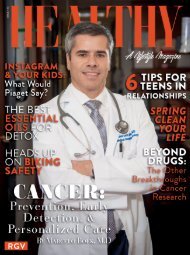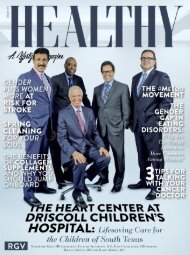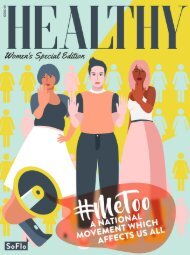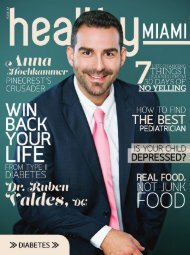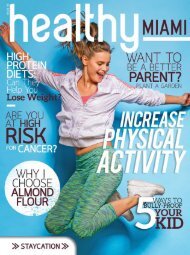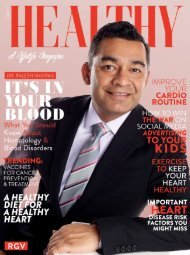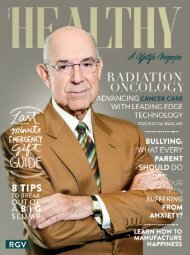Healthy RGV Issue 107 - October Has Us Thinking Pink
You also want an ePaper? Increase the reach of your titles
YUMPU automatically turns print PDFs into web optimized ePapers that Google loves.
COVER STORY · OCTOBER 2017<br />
OCTOBER HAS US<br />
THINKING PINK<br />
BREAST CANCER IS THE SECOND MOST COMMON CANCER AMONG WOMEN, WITH ABOUT A QUARTER MILLION NEW<br />
CASES DIAGNOSED IN THE UNITED STATES EACH YEAR. EACH OCTOBER, BREAST CANCER AWARENESS MONTH<br />
PROMOTES AWARENESS OF THE DISEASE AND THE NEED FOR MORE RESEARCH INTO CURES, AS WELL AS TO CELEBRATE<br />
BREAKTHROUGHS IN TREATMENT THAT HELPED CREATE MORE THAN 3 MILLION SURVIVORS IN THE U.S.<br />
“One in eight women in the U.S. will be diagnosed<br />
with breast cancer in her lifetime. Although it<br />
is the second leading cause of cancer death in<br />
women, it’s important to note that the relative fiveyear<br />
survival rate for breast cancer is 99 percent<br />
for those diagnosed before the cancer has spread<br />
outside of the breast.<br />
One in eight women in the U.S. will be diagnosed with breast cancer in her<br />
lifetime. Although it is the second leading cause of cancer death in women,<br />
it’s important to note that the relative five-year survival rate for breast cancer<br />
is 99 percent for those diagnosed before the cancer has spread outside of<br />
the breast. While the disease occurs most frequently in women, an estimated<br />
2,470 men will be diagnosed with breast cancer in the U.S. this year. Other<br />
than adopting a healthier lifestyle, early detection with regular mammograms<br />
remain the single most effective way for combating the disease.<br />
RISK FACTORS<br />
The chance of an individual developing cancer depends on many factors,<br />
including genetics, personal and family medical history, and lifestyle<br />
influences. Risk factors include:<br />
ɬɬ<br />
Age: Most invasive breast cancers occur in women over age 55.<br />
ɬɬ<br />
Family History: Women with an immediate family member (mother,<br />
sister, daughter) who has had breast cancer are twice as likely to develop<br />
the disease. Having close male relatives with the disease also increases<br />
risk. If you have a family history of cancer, genetic testing may help<br />
determine your risk.<br />
ɬɬ<br />
Diet and Exercise: Overweight and/or physically inactive women have a<br />
higher risk of developing breast cancer.<br />
ɬɬ<br />
Breast Conditions: Women with dense breast tissue and some benign<br />
breast conditions are at higher risk.<br />
Some women are at higher risk and should consider additional steps<br />
to protect their health.<br />
+ + Women with a family history of breast cancer should discuss genetic<br />
testing with their physicians. If genetic tests indicate a woman is BRCApositive,<br />
there are several risk reduction strategies to discuss with her<br />
physician.<br />
+ + Women with a first degree relative who had breast cancer before age<br />
50 should begin receiving mammograms 10 years before reaching that<br />
relative’s age at diagnosis.<br />
PREVENTION<br />
There are steps women can take to help prevent cancer. About 20 percent of<br />
cancer deaths in the U.S. could be prevented through maintaining a healthy<br />
weight, limiting alcohol consumption, practicing healthy nutrition, and being<br />
physically active. Because people can change living habits, the opportunity to<br />
prevent cancer is within our grasp.<br />
16 HEALTHY MAGAZINE



